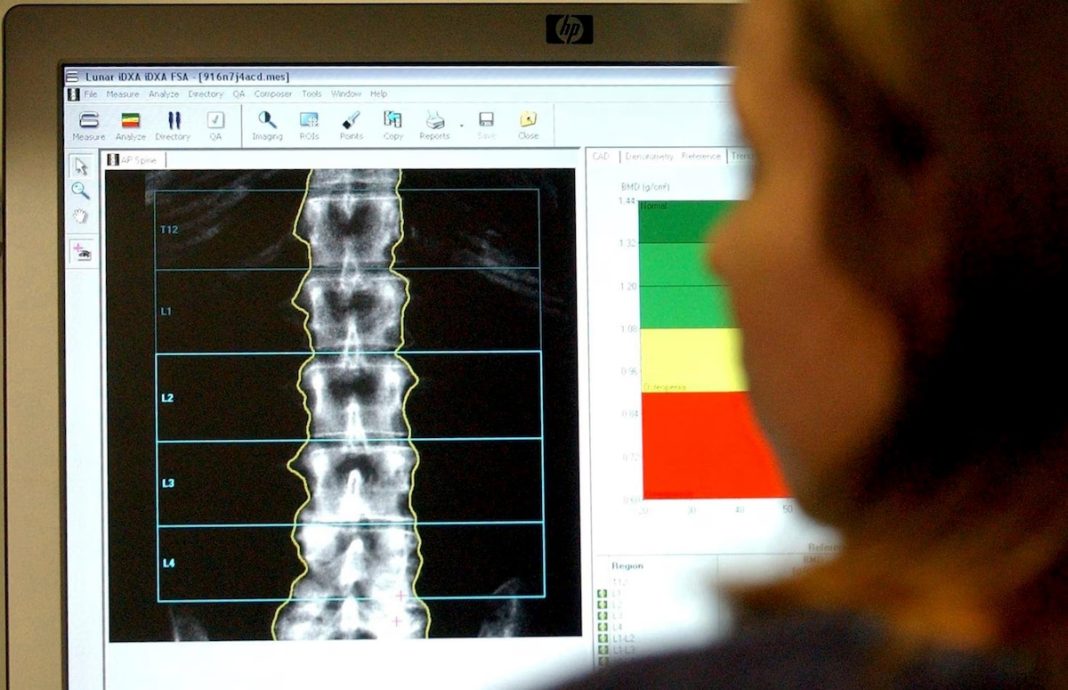Worried about osteoporosis? Here are the tests, moves, meds and foods you need to know about.
But there’s plenty you can do to help prevent the bone breaks these conditions can cause. “Osteoporosis is a chronic disease, just like high blood pressure or diabetes,” says Andrea Singer, director of bone densitometry at MedStar Georgetown University Hospital in D.C. and chief medical officer at the foundation. “But with the right lifestyle changes and medications, we can treat it effectively and significantly reduce fracture risk.”
Still, knowing what to do may not always be clear. The answers to the following key questions on screening, lifestyle strategies and medication can help you make the best moves.
When should you have your bones checked?
The BHOF recommends having a baseline dual energy X-ray absorptiometry (DXA) scan, a painless measure of the calcium in your bones, at age 65 for women and 70 for men. But people at higher risk for weak bones should usually do this around age 50.
Factors that make a good case for earlier screening include a family history of osteoporosis, a broken bone after age 50, a vitamin D deficiency, a smoking habit, medical conditions such as diabetes or rheumatoid arthritis, or previous or current use of medications that can weaken bones, such as the steroid prednisone and certain antidepressants.
How often it should be repeated depends on your results, says Harold Rosen, an endocrinologist at Beth Israel Deaconess Medical Center in Boston. If your initial scan is normal and you have none of the risk factors above, it’s probably fine to wait a decade. If you have osteopenia but no risk factors, you’ll need a repeat scan in three to five years.
For those at high risk for osteoporosis or those who already have it, scans every two years are wise. “We often do a repeat scan a year or two after a patient starts or changes their osteoporosis medication to evaluate their response to treatment,” Singer says. “We may also repeat it in one to two years if the patient isn’t on medication but is high risk and close to crossing into the osteoporosis threshold.”
Does it matter where you go for bone density testing?
Yes. While a DXA is quick and simple for patients (you lie on a table while a movable scanning arm passes above you), “it requires highly trained staff to perform the test and interpret the results,” Singer says. She recommends a facility whose staff is certified by the International Society for Clinical Densitometry. (The testing is usually done in hospital radiology departments, private radiology practices and stand-alone clinics.)
Most bone-density centers use the Fracture Risk Assessment Tool (FRAX) to determine your 10-year risk of fractures in your spine, hips, shoulders and forearms. This tool can help guide treatment decisions for adults with osteopenia who aren’t yet taking osteoporosis medications. But you may want to ask whether the facility you’re considering will also calculate your trabecular bone score, or TBS. This newer measure, which isn’t available everywhere, “provides a better sense of the underlying microarchitecture or quality of your spine” and risk of fracture, according to Singer.
Your doctor says you have osteopenia. Now what?
It depends largely on your level of risk or FRAX score. “If someone has osteopenia but a low to moderate 10-year fracture risk, we’ll take a different approach than we would for someone with osteopenia who’s at high risk,” Singer says. For instance, if your 10-year probability of a major fracture (spine, hip, shoulder or forearm) is 20 percent or more, your doctor will probably start you on meds to prevent more bone loss and reduce fracture risk.
Otherwise, lifestyle measures are the best course, says Clemens Bergwitz, an endocrinologist at the Yale School of Medicine in New Haven, Connecticut. Most slow bone loss or maintain the bone density you have, except for exercise, which may actually help build bone strength. “When patients who have previously been sedentary start to exercise, we often see that their bone density even improves slightly, even if they have osteoporosis,” Bergwitz says.
Your doctor will probably want you to stick to low-impact activities, such as brisk walking or using an elliptical trainer, instead of those that require jumping or running. For strength training, start with moves that use only your own body weight, such as wall push-ups or squats. In addition, tai chi and yoga can improve balance and reverse osteopenia at the wrists, when doing moves like downward-facing dog and bridge pose, Bergwitz says. But if you have severe osteoporosis, some yoga poses, such as bridge pose, can hike the risk of bone or joint injuries, according to a 2019 study published in Mayo Clinic Proceedings.
What medication is best for osteoporosis?
If your doctor recommends meds, the first-line treatment is usually bisphosphonates such as alendronate (Binosto and Fosamax), risedronate (Actonel and Atelvia), and ibandronate (Boniva). These oral or injectable drugs (Boniva is injected every three months) slow the breakdown of bone but won’t build it back, says Clifford Rosen, director of clinical and translational research at Maine Medical Center Research Institute in Scarborough.
For severe osteoporosis, your doctor may prescribe an anabolic: teriparatide (Forteo), abaloparatide (Tymlos) or romosozumab (Evenity). These are typically given as daily or monthly injections and they increase the amount and strength of bones, Bergwitz says.
Do you have to take meds for the rest of your life?
No. In fact, many doctors recommend taking a break from bisphosphonates after five to seven years. “They can cause very rare side effects such as thigh fracture or jawbone damage if they are taken for long periods of time,” Harold Rosen, of Beth Israel Deaconess Medical Center, says. One to two years after stopping the drug, your doctor will do another bone scan. If your bone density has dropped, they may advise you to go back on a bisphosphonate for another several years and then reevaluate.
Anabolic drugs are usually taken for only one or two years, Clifford Rosen says. Studies show that’s when you’ll reap the most benefit, and using these for longer periods has been linked to bone cancer in animal studies. But once you stop an anabolic, you’ll need to switch to a bisphosphonate for a while.
4 key ways to build bone strength
- Get enough calcium and vitamin D. Calcium helps keep bones strong, and vitamin D helps us absorb calcium. Women older than 50 and men over 70 need at least 1,200 mg of calcium per day, experts say, ideally from foods such as dairy, canned sardines, kale and fortified orange juice. Adults over 50 need 870 to 1,000 IU of vitamin D each day, but that’s hard to get just from food. Have your levels checked to see whether you need a supplement.
- Eat a variety of produce. This will help you get bone-friendly nutrients such as magnesium and potassium, says Harold Rosen.
- Stay active. It helps slow bone loss, improve balance and strengthen muscles. Aim for at least 150 minutes of moderate activity per week and strength exercises twice weekly.
- Don’t smoke. Women who smoke a pack of cigarettes per day as adults have less dense bones at menopause.



